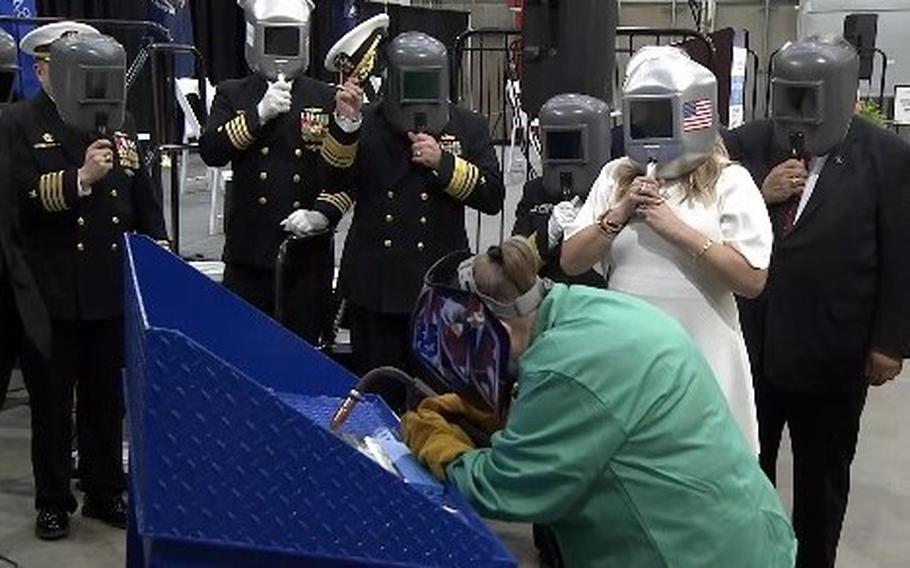
Navy Secretary Carlos Del Toro, far right, admirals and guests watch the symbolic welding of the first plate of the keel of the frigate USS Constellation on April 12, 2024, at the Fincantieri shipyard in Wisconsin. (U.S. Navy)
Top Navy officials rallied around the service’s delay-plagued new frigate program last week by focusing on the symbolic welding of the first plate of the keel on the first of the Constellation-class, guided-missile ships.
Navy Secretary Carlos Del Toro and Adm. Lisa Franchetti, the chief of naval operations, attended the April 12 event at the Fincantieri shipyard in Marinette, Wis.
“The USS Constellation and Constellation-class frigates are a critical next step in the modernization of our surface ship inventory, increasing the number of ‘players on the field’ available globally,” Del Toro said.
The ceremony came near the end of a week in which congressional critics, angry over its delays and cost overruns, excoriated the USS Constellation.
“In a time of constrained budgets, this reflects the gross inefficiencies and problems in our shipbuilding program,” Rep. Ken Calvert, R-Calif., chairman of the House Appropriations Committee’s subpanel on defense, said during an April 10 hearing on the Navy budget.
A Pentagon report obtained by Bloomberg News showed the shipbuilder’s labor needs were worse than officially reported earlier this year. The shipyard requires 1,600 skilled workers in 2025 and has only 900 today, Bloomberg reported.
The American unit of Italian shipbuilder Fincantieri S.p.A. won a 2020 competition to build new frigates for the Navy. The ships were to be built by Fincantieri’s shipyard in Green Bay in northeast Wisconsin, about 170 miles north of Milwaukee. The original contract calls for the French shipbuilder Naval Group to build some later ships.
The frigate will be a modified version of the “European multi-purpose frigate” now in service with France and Italy. The ships are projected to have a top speed of 26 knots and carry a crew of 200 sailors and officers. It can fire anti-aircraft, anti-ship, and ship-to-shore missiles.
An artist rendering of the USS Constellation, the first of the Navy’s new frigate program. (U.S. Navy)
The contract called for the first frigate to be delivered to the Navy by April 2026. However, the Navy has recently pushed the first ship delivery date to 2027, with some internal Pentagon estimates putting the latest date in early 2029.
The recently released Navy shipbuilding budget for 2025 is smaller than previous budgets. Del Toro, Franchetti and budget planners want to slow purchases of the frigates and Virginia-class attack submarines to use the savings for an across-the-board infusion of funds into improving the sprawling subcontractor supply chain and beefing up the recruiting and retention of skilled workers at defense industry plants.
“I am committed to restoring the shipbuilding might our nation once had — both commercial and naval — and to ensuring that we get our major shipbuilding programs back on track — on-time and on-budget,” Del Toro said Friday.
The first four frigates will be sent to Naval Station Everett in Washington state, which will eventually serve as homeport to as many as 12 of the ships.
Fincantieri Marine Repair, a subsidiary of the Wisconsin shipyard, signed a lease March 12 with the Port of Everett Commission to eventually establish a repair shop for the frigates adjacent to the naval station, according to local officials. They emphasized the Navy plan calls for unspecified spending on “post-delivery support and crew training,” some of which would be done at NS Everett.
The port panel said the move was a tangible sign of the Navy’s planned expansion at Everett.
“We value the strong partnership we have with Naval Station Everett and strive to be a good neighbor and fierce advocate of the U.S. Navy,” said Lisa Lefeber, CEO and executive director of the Port of Everett. “Naval Station Everett is one of the largest job creators in Snohomish County, so the port has been investing heavily to further support trade, jobs and national defense.”
NS Everett is about 50 miles north of Naval Base Kitsap. The Navy operates a destroyer squadron out of the Everett station. While Naval Air Station Whidbey Island is nearby, most of the Navy presence in the Seattle area is at Bremerton and Bangor along the Kitsap Peninsula.